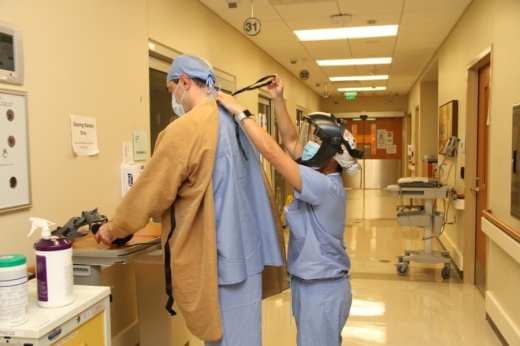This anticipated rise in hospitalizations would come after a 24% increase that occurred between the second and third weeks of June.
The medical center released a model June 19 that uses real patient data from Collin, Dallas, Denton and Tarrant counties to predict how the virus is spreading across the region.
The uptick in hospitalizations is likely tied to an increased number of young people testing positive for the virus, Dr. Mujeeb Basit, UTSW assistant professor of internal medicine and cardiology, said during a June 22 press conference.
So far in June, 50% of hospitalized patients and 30% of patients in critical care have been under the age of 50, the model found.
“This is an alarming trend we feel is associated with the relaxation of [non-pharmaceutical interventions] and rapid spread amongst different age groups,” Basit said.
Non-pharmaceutical interventions include wearing masks, using social distancing, practicing good hand hygiene and staying at home. The model considers the effectiveness of these measures to determine future spread.
“The more consistent we are in the application of those measures, the more of a positive impact we have,” he said.
Social distancing and other prevention methods are currently about 63% effective, the model found. If the region continues on the current trajectory, Basit said, it will see an increased number of infections, hospitalizations and intensive care unit admissions.
But small changes to behavior can greatly reduce the cases projected, Basit said. The model predicts that if measures were even 2% more effective, DFW would see a significant reduction in cases between now and November. If they were 5% more effective, DFW would have effectively no new cases by November.
“Even an ineffective solution ... if it is used by sufficient people, can make an enormous impact in spread of the disease,” Basit said.
Testing data is a less reliable indicator of the outbreak’s severity because it can be skewed by capacity or reporting delays. Hospitalizations, however, are not susceptible to those variances, Basit said.
“If you are sick enough to require hospitalization, you come to the hospital,” he said.
Capacity for COVID-19 patients at regional hospitals is still relatively under control, Basit said. However, that can quickly change if there is exponential growth in new cases, he said.
Medical centers have been preparing for a potential surge in admissions ahead of the upcoming Fourth of July holiday. Large gatherings could lead to a significant increase in the spread of the virus, Basit said.
“The big unknown is July 4th,” Basit said. “We have been on a stable trajectory until we have a major holiday, and those major holidays have really affected the curve quite significantly.”
DFW hospitals saw increased COVID-related admissions two weeks after Easter and Memorial Day, according to the model. The Fourth of July is more concerning because there is not enough time between Memorial Day and July 4 to flatten the curve, Basit said.
Basit and his colleague Dr. Julie Trevedi urged the public to practice good judgment when deciding whether to visit a public place.
“We understand that being able to socialize with other people is part of our humanness. We are social creatures ... There are ways to do things safely,” Trevedi said.







